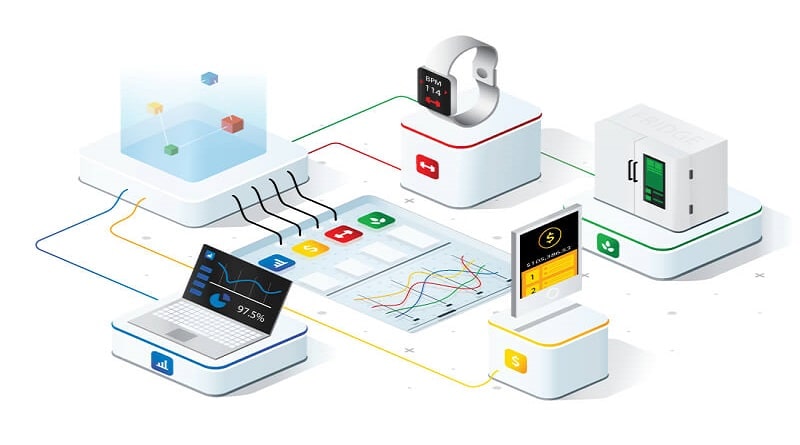The Internet of Things (IoT) and DevOps are the most recent additions to the information technology sector. DevOps stands for development and operations, while IoT stands for the internet of things. DevOps’s role in IoT is a software delivery process that stresses collaboration between the operations and development teams. Product lifecycle management, development operations, and software experts are all included.
IoT development indicates the betterment of normal life with the introduction of smart electronics. None of it can be achieved without constant upgrades. To make said upgrades one needs to make way for DevOps to function. But before we jump into the link between it and the Internet of things, we should understand that they are separate.
What is DevOps?

DevOps focuses on automating the process of product testing, software integration, infrastructure modifications, and deployment adjustments. The main goal is to create a healthy atmosphere in which software development, testing, and release can happen rapidly and consistently.
With DevOps, you can make changes and upgrades to your daily software among other things. This ensures a faster and more efficient network of workflow. Additionally, it aids in the management process and provides applications with a high velocity. Why is DevOps preferred? The entire process of upgrades is done with traditional software development.
The entire process of DevOps is end-to-end. Software development companies make tools and other ways to cater to personalized needs. The process begins with coding, making the tools, adding updates, and finally deploying the end product. With its agile approach, the DevOps team should be able to build, test, and finally launch the software.
What is the Internet of Things?

First and foremost, IoT development is a component of automated security testing (continuous testing), integration testing (continuous integration), and deployment (continuous deployment).
Read: Importance of the Cloud in the Internet of Things
What we generally refer to as ‘things’ are the physical objects that aid our day-to-day life. These ‘things’ are made smart with the addition of technologies. Such technologies include sensors, machine learning, analytics, and other software.
Some examples of IoT include security systems, smart refrigerators, and television. They also include thermostats, wireless control systems, and even smartphones. But the most impact that IoT has made over the healthcare system.
They possess data and use it to provide service to the patients and providers. These systems include the IVR and other virtual teaching systems.
When testing an IoT application, a DevOps system must consider the security of the data collected from sensors. These are vulnerable points of entry, such as a hacker gaining access to your thermostat and providing false data. To guarantee that vulnerability is minimized, DevOps security testing tools must regress via the IoT application. With the increase in reliability over artificial intelligence, especially with software like IoTs, data is an important factor. The collection of data is constantly updating which is why; there may be room for privacy breaches. Hence, the firewall should be tested regularly to ensure that there is no vulnerability that is easily traceable.
IoT and DevOps: What’s the Connection?
DevOps is the entire automation of Agile, using procedures and technologies to remove obsolete delays from application development. Both ISVs (independent software providers) and organizations may benefit from DevOps transformations. People in the IT sector understand how critical it is to make the most of big data, cloud computing, and the Internet of Things (IoT).
The links may be a little difficult for some people to grasp. If you question IoT system managers about the optimal DevOps implementation, you will not get satisfying responses. However, if you pay close attention, it’s not difficult to understand.
To begin with, the Internet of Things is built on automated integration testing, security testing, and deployment. DevOps systems from a software development company need the information sent by sensors to be checked for security. Unfortunately, these access points are readily hacked, similar to someone manipulating your thermostat and sending false data. DevOps security testing tools should regress via the internet of things (IoT) application to ensure that the exposure is decreased.
Ongoing integration
Continuous integration ensures that DevOps-related Internet of Things (IoT) applications are regarded as a whole system or application. As a result, even components that aren’t under direct control, such as sensors implanted in machinery, rely on one another. This differs from typical DevOps approaches, in which all elements are under direct management.
Continuous integration guarantees that DevOps-enabled IoT apps and others that aren’t are all regarded as a single application or system. Even components that are not directly under your control, such as sensors embedded in machinery, rely on one another (e.g., a jet engine). This is a significant departure from typical DevOps techniques, which place direct management of overall components.
Deployment
When it comes to DevOps IoT, deployment is considered the most important component. The application must be able to live on the platform as well as operate and play on distant devices. As a result, the deployment processes become more difficult. For example, there might be some upgrades to the program on a central cloud platform and firmware updates on a device or a distant sensor.
Consider the smartphone applications that allow you to control WiFi-enabled ceiling fans. When the app is updated on both Android and iOS devices, they will very certainly need to send an update to the ceiling fan as part of the deployment procedure, assuming the app requires a firmware upgrade to support the new improvements. To make the deployment effective, all of these activities must happen at the same time. Updating one or the other might result in system failure and depressed fan owners.
What are the benefits of this connected effect?
Most people may find it difficult to comprehend many issues related to Development Operations and the Internet of Things.
Despite the fact that certain organizations may have problems with DevOps and IoT, connections may be made, and individuals can profit from the marriage of DevOps and IoT. IoT application developers are already aware of these linkages and are working to improve communication. Enterprises, on the other hand, are unfamiliar with the notion of ‘Development and Operations’ (DevOps). As a result, they must still get on board.
The Internet of Things is delivering a dramatic shift to the IT sector, and consumers have begun to reap the advantages. As a result, the function of DevOps in IoT (the internet of things) is critical. We’ll go through six reasons why DevOps is important in IoT in this article.
• The Spreading Effect: If the most recent edition of a software program is being updated on a server on a regular basis, then systems linked to that server or relying on that software will require frequent updates as well. This cycle will continue until someone stumbles into something revolutionary. After which the process will keep updating to enrich that. It is like the domino effect where one tile brings down the entire pattern by starting a chain of events.
• The Evolution Effect: At the end of the day, DevOps will exist in whatever shape or form as the next step in the evolution from agile development to continuous deployment. It will continue to grow and create new opportunities every day. The link between DevOps and IoT will bring out new possibilities. The entire process makes the lives of people easier and swifter. Hence it is more likely to have more room for its development simultaneously enhancing the lives around it.
• Software-Defined ‘Anything’: The program or software loaded on the hardware defines the system’s functioning. As a result, we need to update the software when the functionality has to be changed rather than making electrical or mechanical adjustments.
• Installed Infrastructure: People link systems to the World Wide Web and the cloud in today’s modern era of technological progress. As a result, it’s feasible to remotely install and update the software on various devices. All one has to do is to be present with an active internet connection. Linking systems and exposing them globally is a couple of clicks and swipes away.
• Cost Efficiency and Productivity: A method that improves the development cycle without compromising quality by using a smarter, quicker, and better approach with the potential to reduce manufacturing costs.
• New Business Models and Revenue Streams: The main goal of the Internet of Things is to open up new business models. Instead of selling out a one-time product, DevOps has offered to constantly supply a fresh software update to trade the service that will generate money.
• More jobs: With new opportunities coming up every day, people will be in need of more updates and more products. This will lead to the opening of new job portals around the world. Every aspect of the economy shall be affected by these developments. Additionally, new sectors will launch every day to add to the software building and deployment process.
DevOps is the automation of Agile via technologies and procedures that eliminate traditional application development delays. Both businesses and ISVs that I work with these days are undergoing DevOps transitions. Everyone now understands the need to maximize the use of cloud computing, big data, and, more recently, the Internet of Things (IoT).
Most people, however, are unaware of the links. When you ask IoT system managers where DevOps fits in, the majority of them have no idea. It’s rather simple and not at all difficult. Let me walk you through the main ideas.
Why DevOps in IoT?
Most businesses currently have agile technology in place, as well as continuous development and deployment of software. As software release cycles shorten, the same may be anticipated of the devices that support them. DevOps has received a lot of acclaim in the IT world to simplify code, assure high-quality software with more automation, and shorten time-to-market.
The benefits of DevOps may be pushed even farther to the realm of genuine IoT devices. Even when working with actual IoT devices rather than merely code, the connections are clear.
DevOps, for example, maybe highly effective in bringing greater synergy into corporate processes, achieving release schedules, and discovering errors/defects in real-time due to its culture of cooperation and information sharing.
The capacity to continually update devices and functionality affords organizations new chances for business and innovation, which is the other argument for DevOps in IoT. In addition, the financial effect of using the DevOps approach in product engineering organizations makes a compelling argument for DevOps.
Is it a dream or a nightmare?
The issue that comes to me is why hasn’t DevOps in IoT been embraced more extensively if it’s as inevitable as it seems and if it provides such a significant competitive advantage?
The reason for this is that implementing DevOps in IT differs significantly from doing DevOps in IoT. For additional information, see this white paper. On the other hand, the problems that IoT firms encounter may be reduced by having the courage to accept change and putting in place the appropriate technologies.
The key to ensuring that a DevOps implementation does not turn into a nightmare for an IoT firm is to ensure that DevOps is not forced into the organization. Every IoT ecosystem is distinct and has its DevOps solution.
It’s crucial to keep in mind that DevOps isn’t only a combination of development and operations. It is a cultural change toward collaborative working and smaller solutions. The Internet of Things, on the other hand, is all about people. To create the ideal customer experience, connect devices, processes, people, and things.
Wrap up
Simply defined, DevOps is a solid handshake between developers and operations personnel. It’s a mental transformation, as well as greater integration and teamwork. It brings development and operations teams together and enables them to be more efficient, innovates quicker, and produce high-value work.
DevOps is a collection of techniques that automates custom web development company and IT teams’ processes to build, test and deploy software more quickly and reliably. The idea was created to foster cooperation amongst teams that had previously operated in silos. As a result, it impacts how you create systems, organizes teams, and even the structure of the system you’re working on.








